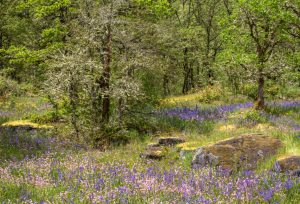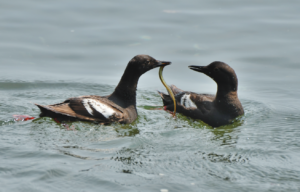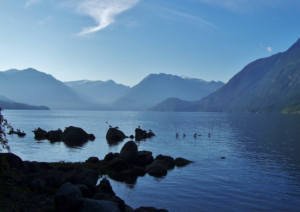 by Sue Danver – The 745-acre property in South Thurston County, once threatened by a proposed South Sound Logistics Center by the Port of Tacoma (POT), is again in danger of huge industrial development. The land borders the 800-acre West Rocky Prairie Preserve (WRP) that Black Hills Audubon worked to save many years ago. A development company from Missouri named North Point is asking the county to re-zone the whole property to Industrial zoning. We have been told that the company would like to build 6 million square feet of warehouses.
by Sue Danver – The 745-acre property in South Thurston County, once threatened by a proposed South Sound Logistics Center by the Port of Tacoma (POT), is again in danger of huge industrial development. The land borders the 800-acre West Rocky Prairie Preserve (WRP) that Black Hills Audubon worked to save many years ago. A development company from Missouri named North Point is asking the county to re-zone the whole property to Industrial zoning. We have been told that the company would like to build 6 million square feet of warehouses.
Washington Department of Fish and Wildlife (WDFW) has long valued this entire biologically precious site (its preserve plus the 745 acres owned by the Port of Tacoma) for many reasons. It is a large and contiguous area with a diverse mix of rich habitats that support prairie, oak, and wetland species. There are several State Priority Species there. The area has the soils preferred by the Federally Threatened subspecies of the Mazama Pocket Gopher. WRP is one of the few areas in Washington where there is a population of the Federally Threatened Oregon Spotted Frog.
POT’s 745-acre site currently has a gravel mine that was permitted by the county in 2006. The project’s Special Use Permit (SUP) and a Settlement Agreement (SA) negotiated with conservation groups and signed by BHAS stipulate that the mine has a 20-year life. The SUP states: “When the mining operation is complete, the property would revert to non-industrial rural uses. The proposed reclamation plan would create lakes, wetlands, and upland forest areas.”
Industrial zoning would not only threaten the health of WRP’s prairie habitat and its sensitive prairie species, but also would likely result in an explosion of warehouse supportive industries into the surrounding beautiful rural and agricultural area, which includes nearby popular and historic Millersylvania State Park. The mine area is known for its high water table. It would be very difficult to manage the runoff from a large area of impervious surface. It can be assumed that water quality and quantity will be compromised. We are also concerned about the impact that all-night lights, noise, air pollution from truck traffic, and the pesticides (that are required with rail operations) would have on WRP.
The 1600-acre parcel that includes both WRP and the Port of Tacoma property has a long and complicated history. WDFW has sought to buy all 1600 acres since the 1990s but previous owners have refused. The 2005 SA was a compromise in which the developer would sell the southern 800 acres to WDFW and allow the owner of the northern half to mine 284 acres. BHAS was the signatory of the SA. But since the SA, there has been little mining at the Port’s Maytown mine. Because of this and a strong desire to own all 1600 acres, WDFW garnered several grants and has offered, for several years, to buy the Port’s property at its appraised value. The Port has refused these offers. Sadly, a State grant disappears June 30, 2019, which reduces the chance of a future WDFW purchase.
Thurston County did not notify BHAS and other members of the public of the April 3 briefing by Thurston County staff to the Board of County Commissioners (BOCC). Fortunately, BHAS learned of the meeting and managed to submit an email prior to the briefing. BHAS requested the BOCC to adopt the staff’s recommendation which was to not add the North Point industrial zoning request to the 2018-2019 Comprehensive Plan Docket due to the anticipation of a massive outcry from Thurston County citizens and the time needed to resolve complex issues.
At the time of this writing, the next Commissioner briefing is scheduled for April 24 at 2 p.m.; a decision about whether to place the requested rezone on the 2018-2019 Comprehensive Plan Docket will most likely be made at that meeting. To stay informed on this issue, please go to the BHAS website for the current status of the BOCC decision and to find out how you can comment on this issue.
In conclusion, sometime after 2007, 2,000 citizens signed a petition to protect this unique landscape, prevent industrialization there, and keep South Thurston County rural. We hope that County Commissioners have realized or will realize that one company’s request should not outweigh the desire of thousands of local residents. Our elected officials should not allow our water quality and quantity and treasured natural lands be destroyed by outside interests.
For those who like details
As part of the SA, the Conservation organizations received $325,000. With agreement from our partners, BHAS has overseen significant expenditures towards monitoring wells on WRP. Jim Mathieu, the hydrogeologist for BHAS, has analyzed years of data to determine groundwater fluctuation over the course of a year. These studies will provide comparisons of water patterns prior to and post-mining. Water collection and analysis will continue through at least 2020.
The water data is useful to understand water level fluctuation in the wetlands just south of the Port/WRP boundary. The Federally listed Threatened Oregon Spotted Frog (OSF) resides in these wetlands. The OSF is very sensitive to water fluctuations during egg laying periods. We are committed to protecting this population of the OSF. In his 2018 report, Mathieu concludes:
“Protecting the existing hydrologic functions within the vicinity of WRP is critical to maintaining the aquatic habitat that OSF requires for its viability. Future land activities (especially mining excavation) in and near WRP should be highly scrutinized for impacts to water conditions, OSF habitat, and frog recovery efforts. (Mathieu, June 2018, p.5)”







